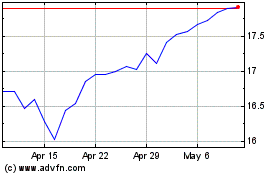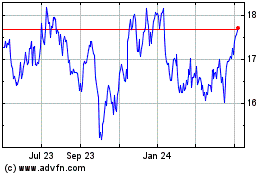By Peg Brickley and Katherine Blunt
This article is being republished as part of our daily
reproduction of WSJ.com articles that also appeared in the U.S.
print edition of The Wall Street Journal (September 24, 2019).
A bondholder group's bid to take control of PG&E Corp. by
paying off massive wildfire damage claims threatens to derail the
company's plan for the mega-billion-dollar bankruptcy case as the
battle over California utility intensifies.
PG&E has a chapter 11 exit plan and backing from major
shareholders. Meanwhile, bondholders led by Paul Singer's Elliott
Management Corp. have an exit plan of their own, which is backed by
victims of the fires that put the company into bankruptcy.
The bondholder plan would damage the company's shareholders. But
the alliance with fire victims in a case that was filed to tackle
$30 billion or more in wildfire damages is a political and
strategic coup for the bondholders. Bondholders, a group comprising
hedge funds, buyout firms and institutional investors, have been in
talks for months attempting to rally wide-ranging public
support.
It isn't game over yet for PG&E's existing leaders, which
have, at least for a few weeks, the sole right to shape the chapter
11 plan that goes out to creditors for vote.
In early October, Judge Dennis Montali will decide whether to
leave PG&E in charge of the proceeding, or open up the field to
competition.
Tom Dalzell, business manager of International Brotherhood of
Electrical Workers Local 1245, said the union supports terminating
exclusivity and generally favors the bondholders' plan for the
protections it offers union members and the structure of the
company. The union had negotiated with the bondholders to ensure
retirement benefits are paid in full under the reorganization plan
and prevent the company from selling parts of its business to
cities launching public takeover bids.
"They've made a much greater effort to communicate with us than
the equity group," Mr. Dalzell said. "They've explained their
position, answered our questions and generally given us the things
that we've asked for."
As shifting alliances shake up the power dynamic of the chapter
11 proceeding that PG&E launched in January, California's
largest utility is struggling to keep its footing.
In a divide-and-conquer move, PG&E on Sept. 13 settled with
Baupost Group LLC and insurance companies seeking repayment for
what they spent on the blazes. The group that had been standing
shoulder-to-shoulder with fire victims, demanding full payment from
PG&E, is now pledged to support the company's plan.
Fire victims turned to Elliott, a hedge fund with a reputation
for sharp tactics in bankruptcy court, and a week after the
insurance settlement was announced, the bondholders and fire
victims announced they had joined forces to challenge PG&E for
control of the bankruptcy.
The combination of the fire victims and the bondholders was a
marriage of convenience, several representatives for the victims
told The Wall Street Journal. But the victims were willing to look
past their reservations if it results in PG&E improving its
offer of about $8.4 billion to people who lost homes and loved ones
in the fires, they said.
TURN, a nonprofit that advocates for PG&E ratepayers, on
Friday added its voice to the call for competition over a chapter
11 plan for the utility.
Monday, both sides flexed their financial muscle, with PG&E
and the bondholders each claiming to have lined up the funding
needed for their chapter 11 plans. Along with Elliott and Pacific
Investment Management Co., the bondholder group has signed up
support from financial giants Apollo Capital Management, and
Oaktree Capital Management, along with other big investment firms,
many of them based in California.
PG&E says it has equity commitments of $14 billion from a
broad group that includes existing shareholders, bondholders and
some new investors. The company's plan, however, could leave
PG&E with at least $5 billion more debt than the bondholder
plan, perhaps more, according to people who reviewed the terms.
"Their strategy is twofold. It's to use creative accounting and
the bankruptcy laws to get this done," said David Frank of Corso
Capital Management in New York, which trades PG&E stock.
"Creative accounting is using multiple levels of leverage. The
bankruptcy law is that, as long as the numbers add up, we can
maintain exclusivity and no one else can come in."
Bondholders want to buy most of PG&E in a deal partially
financed with debt, and give the rest to the fire victims in
partial payoff for their claims. The bondholders are also providing
cash -- $12 billion earmarked for fire victims, including insurance
claims holders and individual victims -- under the plan. There is
cash for bondholders, as well, fees of more than $600 million for
financing PG&E's bankruptcy exit, and hundreds of millions of
dollars more interest than PG&E intends to give them if its
plan prevails.
Shareholders -- including Boston hedge fund Baupost Group --
that have bet hundreds of millions of dollars that PG&E can
exit bankruptcy without sacrificing equity would take a hit under
the bondholders' proposal. Shareholders would get the opportunity
to invest in about 5% of the revamped PG&E, under the
bondholder plan.
In response to the Elliott-led group's plan, PG&E said
Monday that its chapter 11 plan "will continue to be updated as
developments require, including to reflect any additional
settlements or the outcome of the ongoing wildfire claims
proceedings."
The wildfire claims proceedings involve three separate court
proceedings to determine how much PG&E should have to pay for
the blazes. A state court jury trial will test whether victims can
hold PG&E to account for one of the most disastrous fires, the
Tubbs Fire of 2017, while a federal judge conducts hearings on
damages and Judge Montali, in bankruptcy court, handles some of the
legal questions.
The bondholder plan halts those proceedings in favor of a
settlement. Advocates say the end of hostilities with fire victims
ensures that PG&E will get out of bankruptcy in time to meet a
June 30, 2020, deadline to participate in a state fund meant to
cushion utilities against the financial damage of wildfires.
Patrick Thomas contributed to this article.
Write to Peg Brickley at peg.brickley@wsj.com and Katherine
Blunt at Katherine.Blunt@wsj.com
(END) Dow Jones Newswires
September 24, 2019 02:47 ET (06:47 GMT)
Copyright (c) 2019 Dow Jones & Company, Inc.
PG&E (NYSE:PCG)
Historical Stock Chart
From Mar 2024 to Apr 2024

PG&E (NYSE:PCG)
Historical Stock Chart
From Apr 2023 to Apr 2024
